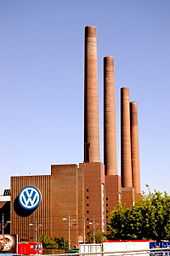BlueMotion


BlueMotion is a tradename for certain car models from the Volkswagen Group with an emphasis on higher fuel efficiency.[1][2]
Volkswagen introduced the name in 2006 on the Mk4 Polo BlueMotion,[2][3] and in 2007 a version based on the current Passat was released. More recently, the technology has been used in SEAT's models like the SEAT Ibiza or the SEAT León under the name 'EcoMotive,[4] and in the Škoda Fabia and Superb, where the technology is called "GreenLine". BlueMotion versions of the Golf Mk5 and Touran were released in 2008. The name refers to Volkswagen Group's corporate colour, blue, with the word 'motion' added to denote mobility,[2] and echoes DaimlerChrysler's BlueTec engines which are equipped with advanced NOx reducing technology for diesel-powered vehicle emissions control.
The BlueMotion Polo (based on the Mk4 Polo) and Ibiza Ecomotive used a special 1.4 L three cylinder Turbocharged Direct Injection (TDI) diesel engine[3] which develops 59 kW (80 PS; 79 bhp) achieves 3.9 L/100 km (72 mpg-imp; 60 mpg-US)[2][3] while producing just 99 grammes of CO2 per kilometre (base model), or 102 g/km with the higher specification trim package (with air conditioning, etc.).[3] The Ibiza was subsequently changed to the 1.2 L TDI engine.
The BlueMotion Golf Mk6 uses a new 1.6 L TDI engine, and Polo Mk5 uses a new 1.2 L TDI engine, which produces 87 to 90 g/km of CO2.[5]
Record-setting fuel economy
The cars combine a fuel efficient engine with state-of-the-art fuel efficient design and technological strategies that include a highly aerodynamic body, a low ride height, auto stop-start, programmed battery charging system (so the alternator only runs when necessary), longer gearing and low rolling resistance tires. It has a fuel capacity of 77.25 litres (16.99 imp gal; 20.41 US gal). It was with such a production model that in the fall of 2010 a BlueMotion Passat set a world mileage record in Europe, recognized by the Guinness Book of Records, achieving 1,526.63 miles (2,456.87 km) on a single tank of fuel, which equates to 74.8 miles per US gallon (3.14 L/100 km; 89.8 mpg-imp). This is equivalent to travelling from New York to Los Angeles on two tanks of diesel.[6] BlueMotion vehicles are not available in North America.
BlueMotion strategy
BlueMotionTechnologies include all products, basic technologies and innovations that significantly improve fuel economy and reduce emissions. These basic technologies represent the foundations of BlueMotion. Currently, they cover the TDI (turbocharged diesel direct injection) and TSI (boosted petrol direct injection) engines as well as the extremely efficient Direct Shift Gearbox (DSG). They are supplemented by technological innovations that include drive variants such as EcoFuel (natural gas engines), BiFuel (liquid natural gas engines), MultiFuel (ethanol engines), hybrid systems and electric drives, as well as NOx emissions control, regenerative braking and the Stop-Start system. These basic technologies and innovations are getting incorporated into a growing range of products. These products / vehicles are currently grouped at Volkswagen Commercial Vehicles into three concept brands: ‘BlueMotion’, ‘BlueMotion Technology’ and ‘BlueTDI’.[7]
The BlueMotion brands represents the most fuel efficient model of its line and has the following:
- Engine
- Revised engine mapping, diesel particulate filters and oxidising catalytic converters[3] help the fuel consumption and lower NOx levels. In the more modern incarnations there's also a start-stop system that halts and restarts the motor at brief stops.
- Transmission
- The last two gear ratios are longer than on standard TDI engine gearboxes.[2][3]
- Reduced rolling resistance
- Low-resistance tires and better aerodynamics through lowered suspension, redesigned spoilers and additional enhancements underneath each car so the air is better channelled giving less drag which produces better fuel consumption.[2][3]
BlueMotion Technology
Volkswagen offers BlueMotion Technology packages over the whole range and it can be configured with TSI and TDI engines. The package includes start-stop system, change gear indicator and regenerative braking technology.[7]
In Brazil
Currently BlueMotion in Brazil focuses on reduced rolling resistance and taller gearbox ratios, among other changes.
The Polo Bluemotion, the first model with the BlueMotion label in Brazil, uses the 1.6 TotalFlex (gasoline/alcohol) engine which is found in the other models. In April 2012 VW introduced in Brazil the Fox Bluemotion with the same engine.[8]
Volkswagen Commercial Vehicles
Volkswagen Commercial Vehicles offer a Multivan, Transporter and Crafter BlueMotion and BlueMotion Technology packages across the whole range.[7]
See also
| Wikimedia Commons has media related to BlueMotion. |
- list of Volkswagen Group petrol engines
- list of discontinued Volkswagen Group petrol engines
- list of discontinued Volkswagen Group diesel engines
- list of North American Volkswagen engines
- Turbocharged Direct Injection (TDI)
- Suction Diesel Injection (SDI)
- ECOnetic Ford of Europe's similar branded low emissions range
References
- ↑ "Case Studies - Volkswagen AG" (PDF). Origin Brand Consultants - Case Studies. OriginBranding.com. Retrieved 2009-07-29.
- ↑ 2.0 2.1 2.2 2.3 2.4 2.5 "Lean and Green: Volkswagen adding fuel-efficient BlueMotion versions to volume car lines". Automotive News Europe. AutoWeek.com. 3 April 2006. Retrieved 26 January 2010.
- ↑ 3.0 3.1 3.2 3.3 3.4 3.5 3.6 "Volkswagen Polo BlueMotion - Volkswagen has given the green light to UK sales of its new Polo BlueMotion". Auto Express. Dennis Publishing Limited. 1 January 2007. Retrieved 26 January 2010.
- ↑ "New SEAT EcoMotive range" (PDF). SEAT S.A. SEAT.com. 1 September 2009. Retrieved 26 January 2010.
- ↑ English, Andrew. "Volkswagen Polo BlueMotion Review". Daily Telegraph, web edition, 22 February 2010. Telegraph Media Group Ltd. Retrieved 29 January 2012.
- ↑ Eric Loveday, "Passat BlueMotion enters record books after going 1,527 miles without refueling; that's 74.8 mpg", Green Car News (blog), 4 October 2010. Retrieved 9 May 2012.
- ↑ 7.0 7.1 7.2 http://vwphaetonfan.blogspot.com.au/2010/10/volkswagen-commercial-vehicles-unveils.html[–discuss]
- ↑ Polo > Volkswagen Brazil (in Portuguese)
| ||||||||||||||||||||||||||||||||||||||||||||||||
| ||||||||||||||||||||||||||||||||||||||||||
| |||||||||||||||||||||||||||||||
| |||||||||||||||||||
